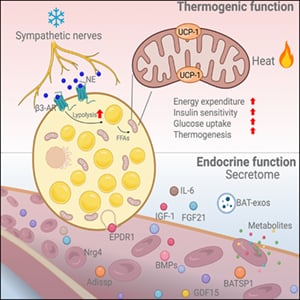Chenxu Yan, George Burley, Hanyu Gao, Yan-Chuan Shi
Endocrinology, Volume 166, Issue 9, September 2025, bqaf118
https://doi.org/10.1210/endocr/bqaf118
Abstract
Brown adipose tissue (BAT), traditionally recognized for its role in thermogenesis, has emerged as an active endocrine organ that coordinates systemic energy expenditure with glucose homeostasis. This review explores the emerging concept of bidirectional crosstalk between BAT and pancreatic β-cells, focusing on potential mechanisms through which BAT may regulate insulin secretion and β-cell survival. In addition to its thermogenic function, BAT serves as a metabolic sink and secretes various hormones (batokines), metabolites, and exosomes that can influence β-cell function directly or indirectly. Key batokines such as fibroblast growth factor 21, IL-6, ependymin-related protein 1, neuregulin 4, and phospholipid-transfer protein have shown potential in the preservation of β-cell health, although their clinical relevance requires further investigation. Emerging evidence also points to BAT-derived exosomes and microRNAs, including miR-26a, as novel regulators of insulin secretion. Neural mechanisms may contribute to this interorgan communication via sympathetic and sensory innervation, and BAT-derived neurotrophic factors may modulate autonomic inputs to peripheral tissues, including the pancreas. Conversely, β-cells influence BAT activation via hormonal (eg, insulin, glucagon), exosomal, and central pathways, forming a proposed BAT-brain-islet axis. This bidirectional communication appears disrupted in obesity and diabetes, where BAT dysfunction and β-cell stress exacerbate metabolic decline. Despite growing interest, mechanistic insights into BAT-islet crosstalk remain incomplete. Future research using omics technologies, co-culture systems, and in vivo manipulation models will be critical to identify novel mediators and clarify their roles in metabolic regulation. Understanding this interorgan communication may offer new therapeutic avenues for obesity and diabetes.
